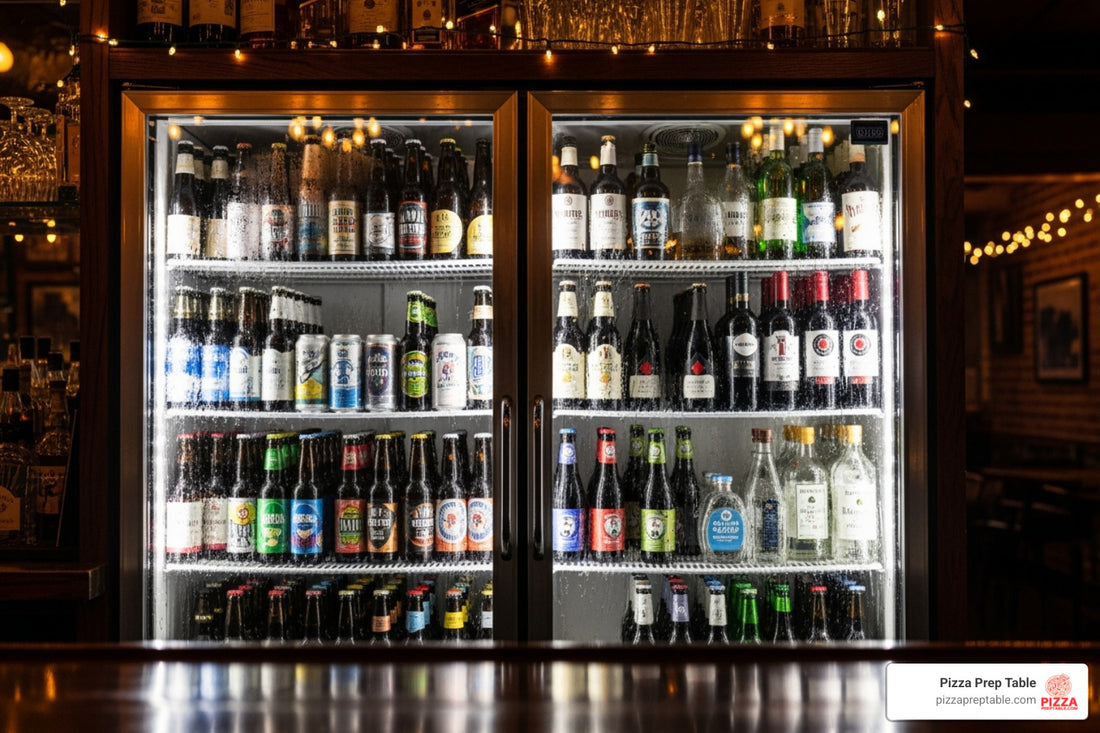
Back Bar Cooler Comparison Survival Guide
Share
Why Every Bar Needs the Right Back Bar Cooler
A back bar cooler is a specialized refrigeration unit designed to store and chill beverages, mixers, and garnishes behind a bar. These compact units maintain optimal temperatures (typically 33-38°F) while maximizing storage in tight spaces.
Key Back Bar Cooler Types:
- Standard Back Bar Coolers - Undercounter units for bottles, cans, and mixers
- Direct Draw Coolers - Integrated keg storage with built-in taps for draft beer
- Pass-Thru Coolers - Accessible from both sides for island bar setups
- Bottle Coolers - Horizontal storage for maximum bottle capacity
Behind every great bartender is an overlooked workhorse: the back bar cooler. It keeps drinks at the perfect temperature, speeds up service, and can even boost sales through attractive product displays.
The benefits are clear: optimal temperature control for better taste, faster service during rush periods, visual merchandising that encourages sales, and smart storage that maximizes limited bar space.
With years of experience helping restaurant owners find the right equipment, I've seen how a quality back bar cooler can transform a business's efficiency and profitability. This guide will walk you through everything you need to know to make the best choice for your establishment.
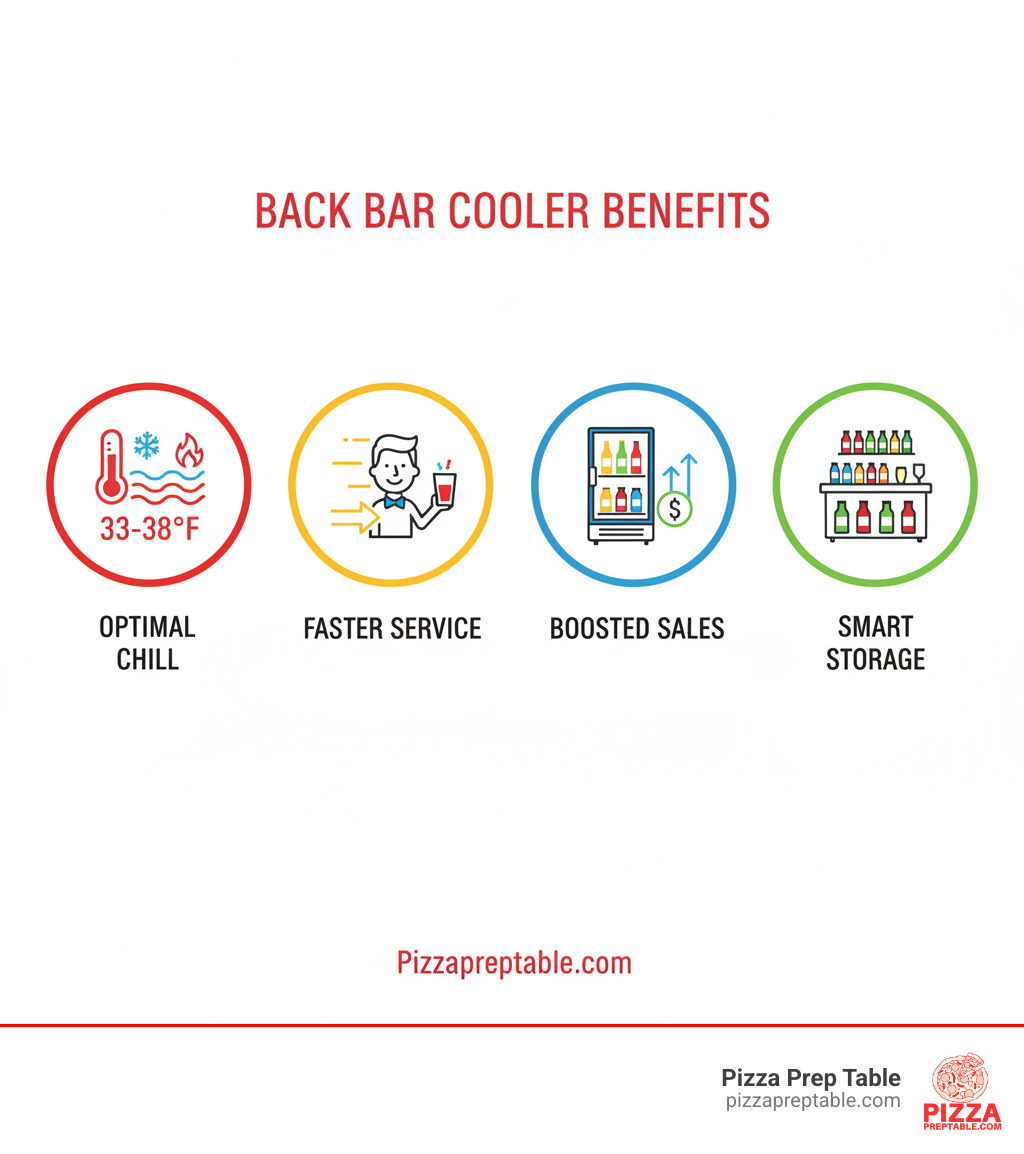
Decoding the Options: Types of Back Bar Coolers
Choosing the right back bar cooler means finding one that fits your space, handles your volume, and streamlines service. Each type serves a different purpose, so understanding the options is key. For a broader look at commercial refrigeration, check out more info about commercial fridge shopping to get the full picture.
Standard Back Bar Coolers
Standard back bar coolers are the workhorses of the bar world. Their undercounter design (typically 34-36" tall) fits perfectly under most bars. Their popularity comes from versatile storage for bottles and cans, with adjustable shelving to customize the interior for different container sizes. As the most common type, they are straightforward, reliable, and adapt to almost any setup.
Direct Draw Coolers (Kegerators)
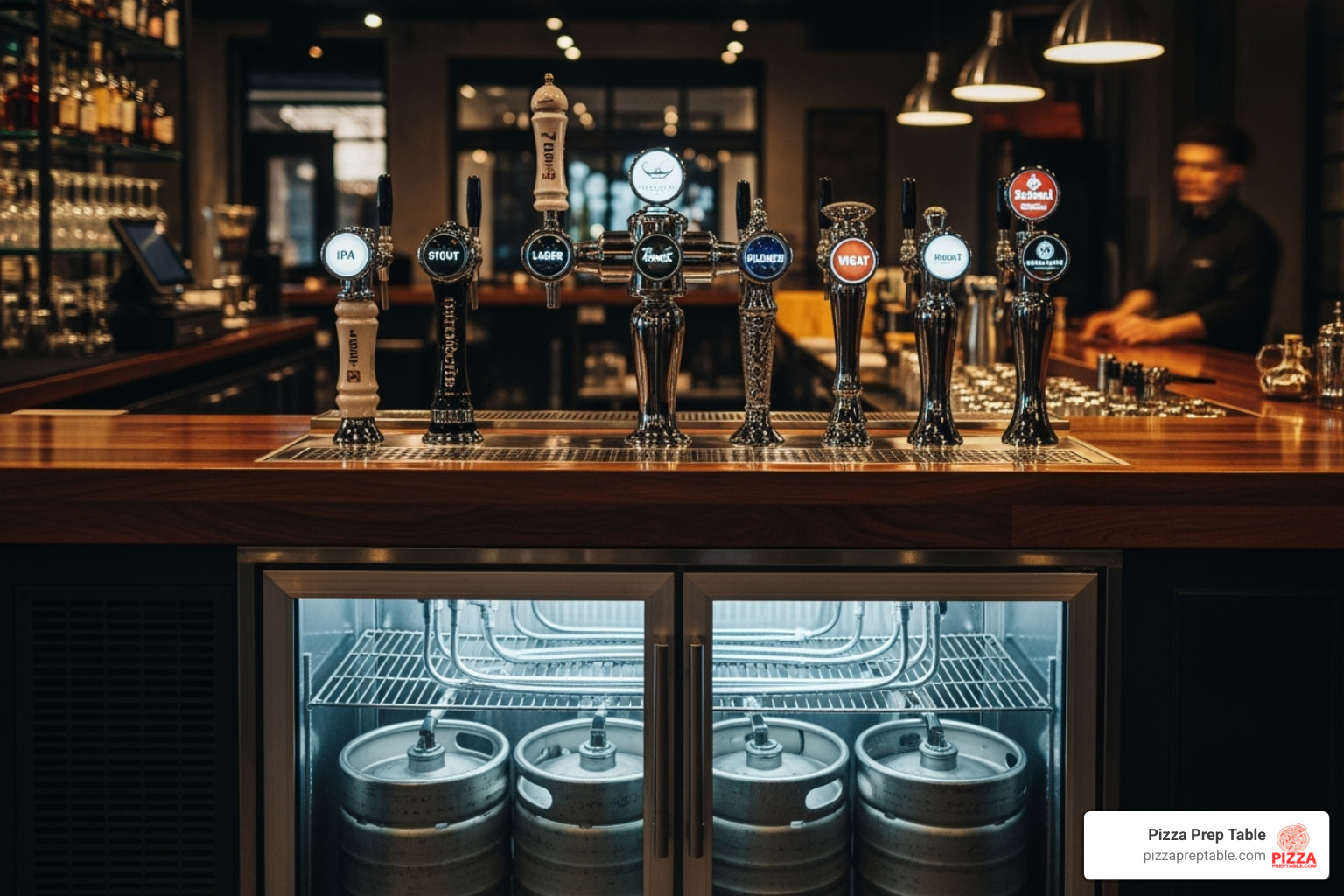
For draft beer, direct draw coolers (kegerators) are essential. They dispense draft beer directly from the keg, ensuring it's perfectly chilled and carbonated. These units hold kegs internally and feature integrated taps and a CO2 system to maintain pressure and freshness. Some models even offer hybrid storage with space for both kegs and bottles. For more insights on essential bar equipment, explore our guide on commercial kitchen equipment.
Pass-Thru Coolers
For an island bar design, pass-thru coolers are game-changers. They are accessible from both sides, allowing staff to stock from back, serve from front. This setup dramatically improves workflow, especially during peak hours, as bartenders can serve uninterrupted while restocking happens from behind. Many brands offer pass-thru models that can transform an operation. Learn more about Krowne's pass-thru models to see how these innovative designs work.
Bottle Coolers
Dedicated bottle coolers use a horizontal, chest-style layout to achieve maximum bottle capacity, packing in more units per square foot than standard upright coolers.
Mug Frosters
Mug frosters maintain sub-freezing temperatures (0-32°F) to deliver perfectly frosted glasses, a premium touch that improves the customer experience.
The Ultimate Back Bar Cooler Buying Checklist
Choosing the right back bar cooler can feel overwhelming, but it becomes much clearer once you know what to look for. This checklist breaks down the key considerations to help you find a unit that will serve your business well for years.
Size and Capacity: Finding the Perfect Fit for your back bar cooler
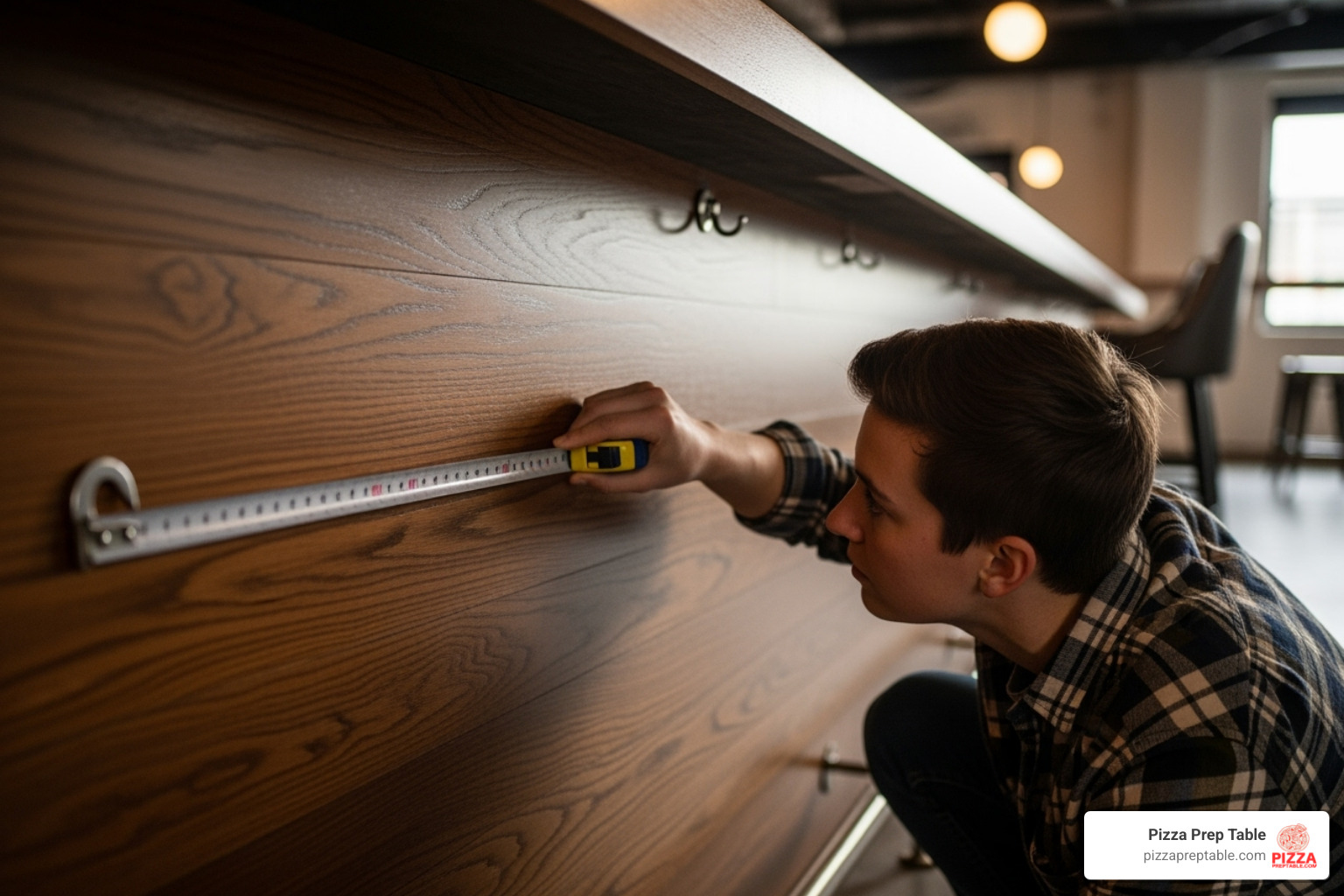
Before buying, measure your space carefully. An ill-fitting cooler is a common and costly mistake.
- Width: Coolers range from compact 24-inch units to massive 108-inch models. Popular sizes (36, 48, 60, and 72 inches) offer a good balance of capacity and footprint.
- Depth: Standard depth is 24 to 30 inches. Narrow-depth models (~24 inches) are available for tight spaces to ensure clear walkways.
- Height: Most units are counter-height (35-36 inches) to slide under bars, with some low-profile models available.
- Capacity: This is measured in cubic feet and by bottle, can, or keg count. Plan for your busiest periods, not your slowest. For more insights, check our guide to under counter freezer capacity.
Doors and Display: Glass vs. Solid Showdown
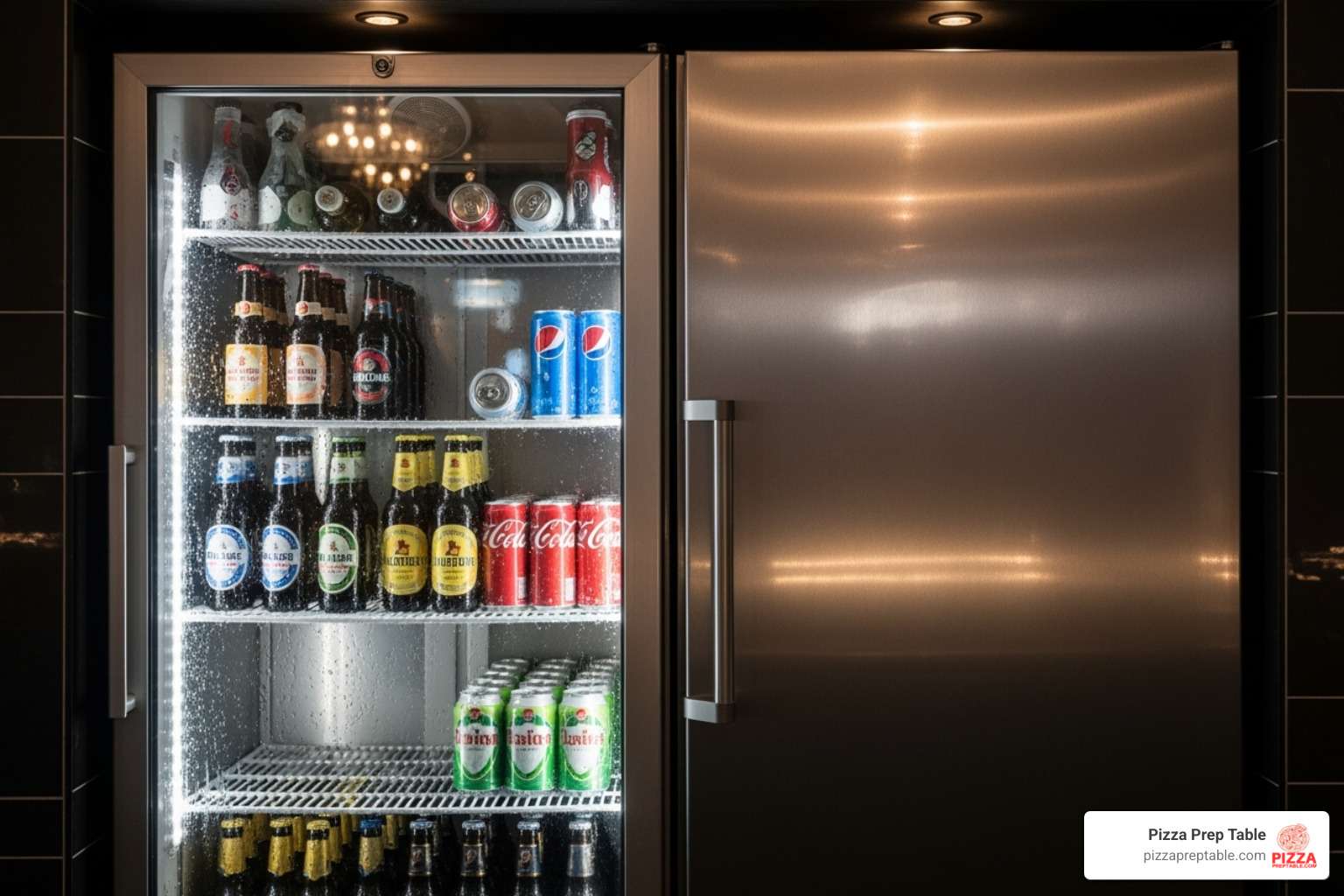
The door style you choose affects both energy bills and sales.
- Glass doors are excellent for merchandising, allowing customers and staff to see the selection and boosting impulse sales. Most feature double-paned, tempered glass. They are less energy-efficient but are a worthy trade-off if display is important. You can explore undercounter refrigerators with glass doors for more options.
- Solid doors offer superior insulation and energy efficiency, making them ideal for storing backup stock and non-display items.
Consider door configurations like space-saving sliding doors or convenient refrigerated drawers. Look for features like self-closing doors to save energy, a stay-open feature for easy loading, and door locks for security.
Performance and Construction: What's Under the Hood?
Quality construction is key to a long service life.
- Compressor Location: Side-mounted compressors are often easier to service without moving the entire unit.
- Temperature Range: The standard range is 33-38°F. Dual-zone temperature control is useful for storing different beverages (like beer and wine) at separate temperatures.
- Exterior Finish: Choose between durable black vinyl or easy-to-clean stainless steel.
- NSF-7 Certification: This is essential for storing open food items like garnishes, as it meets public health standards for sanitation.
- Ventilation: Front-breathing ventilation allows for built-in installation with zero clearance against walls.
Inside, look for full stainless-steel interiors with coved corners for easy cleaning and adjustable epoxy-coated wire shelves. Modern digital controllers offer precise temperature management and automatic defrost cycles. For more details, explore a guide to undercounter freezer features.
Energy Efficiency and Your Bottom Line
An energy-efficient cooler saves money over its lifespan. Look for these features:
- ENERGY STAR certification: Meets strict EPA standards for energy use.
- Eco-friendly refrigerants: R290 or R-600a have low environmental impact.
- LED interior lighting: Showcases products with less heat and energy use.
- High-density polyurethane insulation: Improves temperature stability and reduces energy waste.
While efficient models may cost more upfront, the monthly savings on your electricity bill make them a smart investment. For more insights, check out our guide to food truck fridges and efficiency.
Installation and Operation: Common Issues and Solutions
Proper installation and operation are key to a long, reliable service life for your back bar cooler. Getting it right from the start prevents common headaches.
Place your cooler to optimize bartender workflow and match the compressor's side to your electrical outlets to avoid hazardous cords. Avoid placing the unit near heat sources like ovens, dishwashers, or in direct sunlight, as external heat makes the compressor overwork and increases your electric bill.
Ventilation clearance is critical. While some units need space, most modern back bar coolers are front-breathing, allowing for built-in installation with zero side or rear clearance. For built-in applications, choose a "front-serviced" model so technicians can perform maintenance without pulling the unit out.
Always use the adjustable feet to level the unit perfectly. An unlevel cooler can prevent doors from sealing properly, wasting energy. Before plugging it in, verify your electrical requirements (voltage, amperage, plug type) to prevent damage.
In humid climates, condensation on glass doors can be an issue. Higher-end models include mullion heaters in the door frames to prevent this. Finally, consider noise levels. While all compressors make some sound, look for units designed for quiet operation if your bar has an intimate ambiance.
For more detailed information on proper air circulation, check out our guide to commercial kitchen ventilation requirements.
Keeping Your Cool: A Maintenance Guide
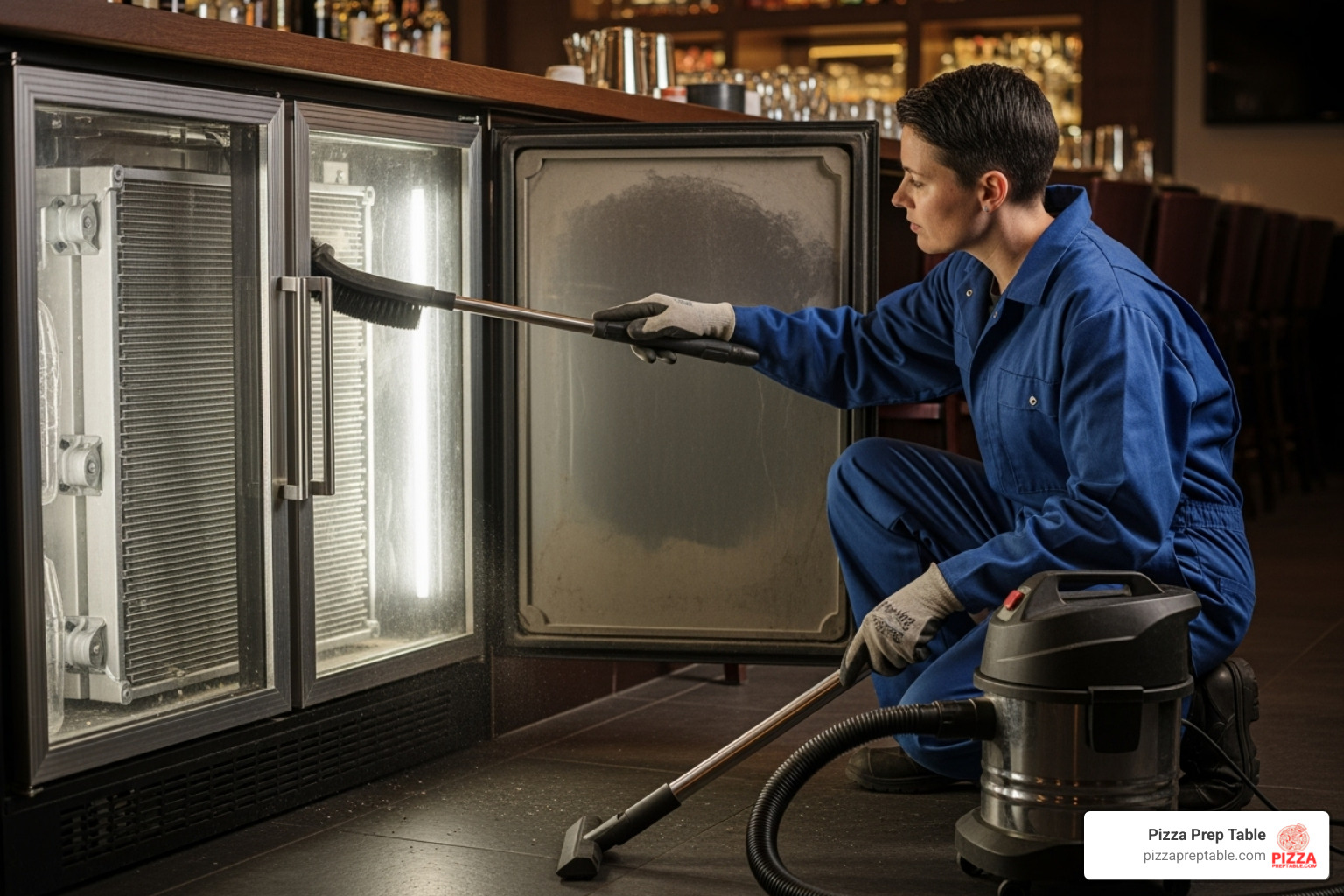
Proper maintenance is essential to ensure your back bar cooler provides reliable service and avoids costly failures during peak hours. Most tasks are straightforward and can be part of a regular routine.
Daily cleaning habits make a huge difference. Wipe down handles and clean interior surfaces with odorless cleaners. Always disconnect power before any deep cleaning.
The most critical task is cleaning the condenser coils at least every three months (more often in dusty environments). Dust buildup forces the compressor to overwork, increasing energy bills and risking failure. Some brands offer self-cleaning condensers that automatically brush off dust, significantly reducing this burden.
Regularly inspect door seals and gaskets for cracks or hardening. A poor seal wastes energy and strains the compressor. Clean them with soapy water and replace them when worn.
Use an independent thermometer to monitor temperature regularly, as this helps you catch cooling issues early. If you store open food, sanitizing interior surfaces is crucial to prevent mold and bacterial growth.
Your cooler's longevity depends on following manufacturer instructions, training staff on proper use, and addressing unusual noises or performance issues immediately. For comprehensive guidelines, check out our food safety guidelines for restaurants.
Top Brands and What They Offer
Choosing the right brand is crucial for a reliable back bar cooler. A quality manufacturer ensures dependable performance, while a poor choice can lead to costly repairs and downtime.
- Krowne: Known for its "Made in the USA" robust construction, full stainless-steel interiors, and fast parts availability.
- Beverage-Air: Delivers reliable functionality with full electronic controls and many 'food rated' models suitable for storing perishable garnishes.
- Turbo Air: Stands out with its patented self-cleaning condenser, which automatically brushes dust off daily to prevent compressor failure and reduce maintenance.
- Perlick: A premium brand offering extensive customization options, including specialized wine and refrigerator drawers, all NSF-7 certified.
- Glastender: Specializes in space-maximizing designs that offer impressive capacity in compact footprints, often with specific temperature zones.
- Hoshizaki: Features stainless interiors with LED lighting and heavy-duty tops, designed to stack tall boy cans three-high.
- Master-Bilt: Strikes a balance between aesthetics and functionality, also accommodating three-high tall boy stacking with sleek finishes.
- Nor-Lake: Combines stainless tops with black exteriors and includes standard door locks and magnetic gaskets for durability.
- Arctic Air: Focuses on easy maintenance with front-breathing, front-accessible condensing units for straightforward service.
- PeakCold: Offers a wide variety of sizes and door types, featuring reliable digital controllers and self-evaporating water trays to reduce daily maintenance.
Each manufacturer brings something unique to the table. The key is matching their strengths to your specific needs and budget.
Frequently Asked Questions about Back Bar Coolers
After helping hundreds of bar owners find the perfect refrigeration setup over the years, I've noticed the same questions come up again and again. Let me share the answers that matter most when you're shopping for a back bar cooler.
What's the difference between a commercial and a residential back bar cooler?
Commercial back bar coolers are built for heavy use with durable materials like stainless steel and powerful compressors that ensure quick temperature recovery after doors are opened. Most importantly, they are NSF certified for health code compliance. Residential units lack this durability, power, and certification, making them unsuitable and often non-compliant for a business environment. The higher cost of a commercial unit is an investment in reliability and compliance.
What is the ideal temperature for a back bar cooler?
The ideal temperature is 33-38 F. This range is perfect for most beverages, ensuring beer is served cold. For wine, consider a dual-zone unit, as white (45-50 F) and red (50-65 F) wines require different temperatures. Critically, any open food items must be stored below 41 F to meet food safety standards. A digital thermostat is essential for maintaining precise control.
Can I store food in my back bar cooler?
Yes, but only in a unit with an NSF/ANSI 7 rating. These coolers are designed for storing open food with features like all-stainless steel interiors and coved corners for easy, thorough cleaning. Without this certification, you risk food safety violations. Always practice cross-contamination prevention by keeping raw ingredients separate from ready-to-eat items and using covered, labeled containers. Storing food requires stricter cleaning schedules to comply with health department standards. For detailed guidance, check out our restaurant food storage guidelines.
Conclusion: Choosing the Right Cooler for Your Business
A back bar cooler is a workhorse that ensures your bar runs smoothly. Perfectly chilled drinks lead to faster service and happier customers, turning a good bar into a great one. The right refrigeration is the starting point for every great drink you serve, making a quality cooler a long-term investment in your bar's success.
Remember the essentials: choose the right size, select a door type that fits your merchandising and energy goals, and insist on quality construction with NSF certification for durability and food safety. Whether you need a compact unit for a wine bar or a large direct draw cooler for a sports pub, the perfect fit depends on your space, volume, and budget.
At PizzaPrepTable.com, we help restaurant and bar owners find the right equipment for their unique situations. We know every dollar counts, which is why we offer flexible restaurant equipment financing for startups and established businesses alike.
Your perfect back bar cooler is out there. The investment you make today will pay dividends in smoother operations, lower energy bills, and happier customers.
Ready to find your ideal back bar cooler? Explore our collection of beverage refrigerators and see how the right refrigeration can transform your bar's efficiency and profitability.
